A raised vegetable garden brings your plants to a comfortable working height, improves drainage, and gives you more control over your plants and soil. Raised beds are also a great project for kids who enjoy gardening since they won’t have to get their knees dirty crawling on the ground. In this segment, This Old House landscape contractor Roger Cook demonstrates how to build a simple but effective raised garden bed out of cedar lumber with a few young helpers.
Planning Your Raised Vegetable Garden
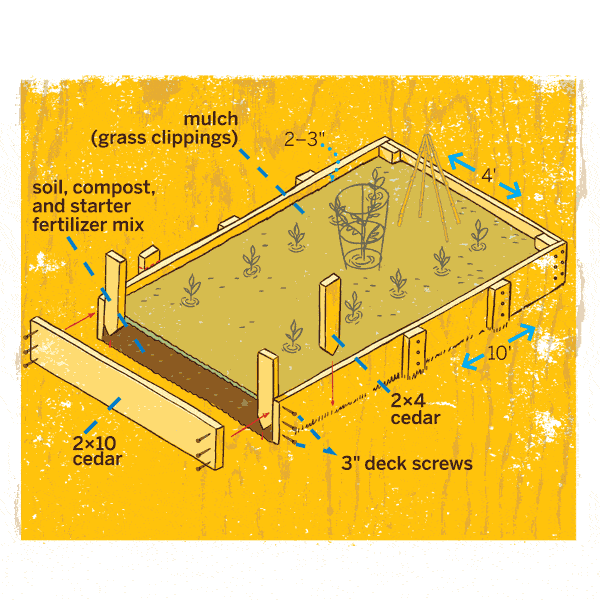
Cedar is an excellent choice for raised gardens for the following reasons:
- It’s rot-resistant.
- It’s safe to use around edible plants.
- It turns a nice silvery-gray color as it weathers.
You can build your garden bed as long as you need, but keep the width no more than 4 feet so your kids can reach the plants in the middle. Allow a little extra room for 2×4 cedar stakes—these will hold the frame in place and keep the sides from bowing with the heavy soil.
Finally, think about where you want to put your raised garden. Many vegetables need at least 6–8 hours of daily sunlight to grow, so Cook places his bed in a full sun area of his yard. Choose an area that has good drainage and till the ground if necessary to stop weeds from growing up into the bed.
Materials and Tools Needed To Build a Raised Vegetable Garden
Cook and his helpers use the following materials and tools for this project:
Materials
- 3-inch coated screws
- Cedar lumber (2×10 boards)
- Cedar stakes (2×4 boards)
- Mulch (grass clippings or other organic material)
- Soil and compost mix
Tools
- Circular saw or jigsaw
- Drill/driver
- Edger or spade
- Framing square
- Grub hoe or sod cutter
- Level (4-foot)
- Pitchfork or rotary tiller
- Reciprocating saw or handsaw
- Sledgehammer
- Wheelbarrow
Building the Frame of the Vegetable Garden
The frame forms the foundation of your raised vegetable garden. Follow these steps to build a sturdy, reliable frame.
Step 1: Cut and Assemble the Sides
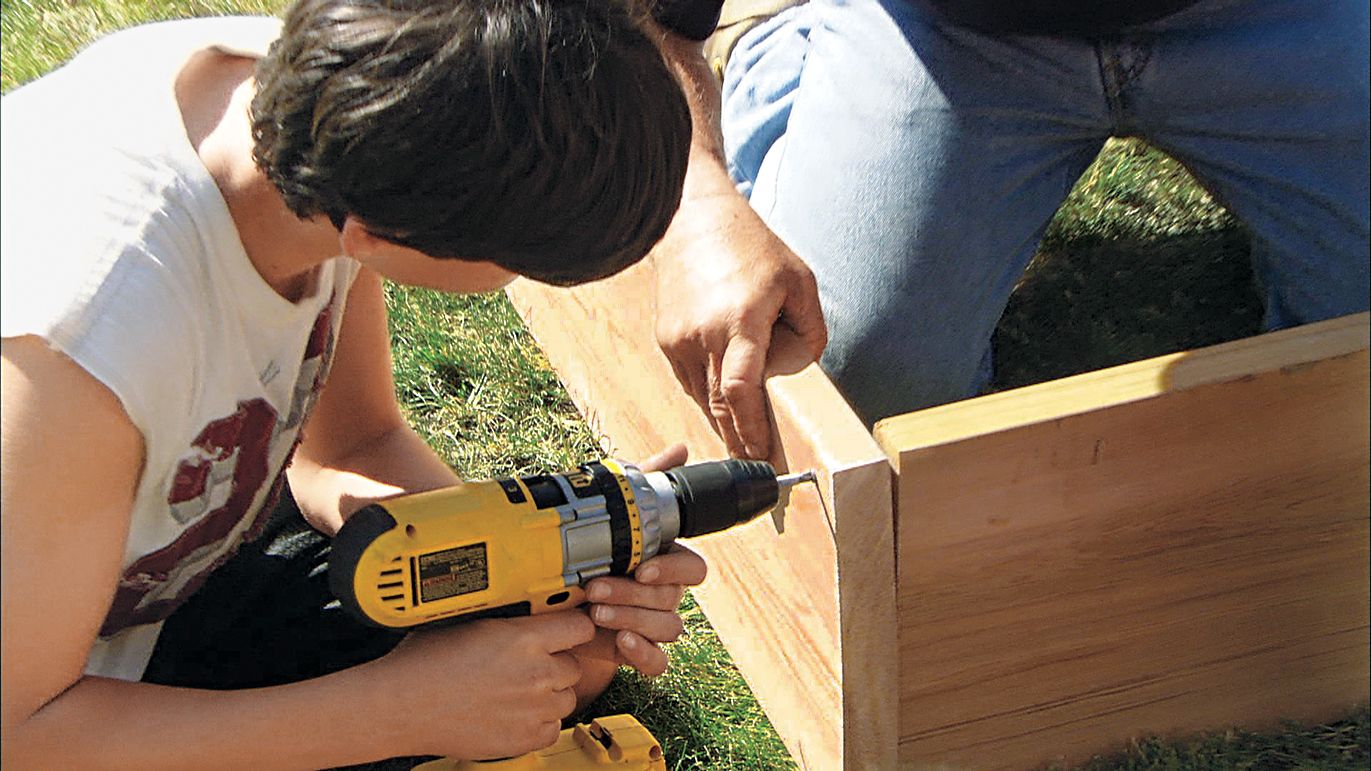
- Cut two 4-foot pieces of 2×10 cedar boards with a jigsaw or circular saw. These will form the short sides of the bed.
- Hold one of the 10-foot 2x10s on its edge and butt the end of the pieces you just cut up to it. The face of the longer board should overlap the end of the shorter board.
- Using your drill/driver and 3-inch screws, fasten the boards together by going through the face of the long sides into the end of the short sides.
- Attach the other sides together with 3-inch screws on each corner.
Step 2: Square Up the Frame
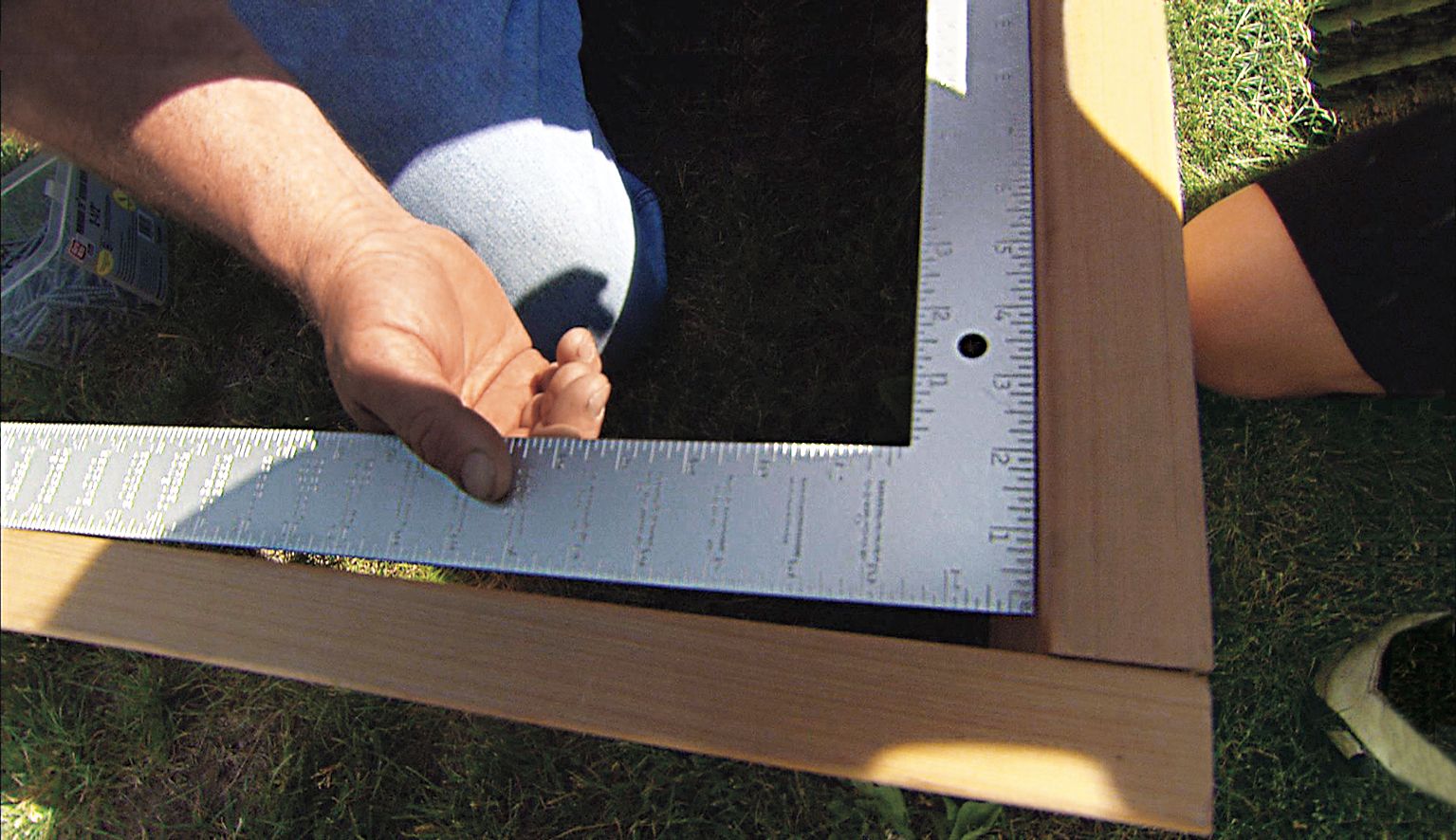
Once you’ve fastened the four sides together, place a framing square in each corner—one at a time—and adjust the frame until the corners line up square. Keep checking the corners with the framing square as you go.
Step 3: Brace the Corners
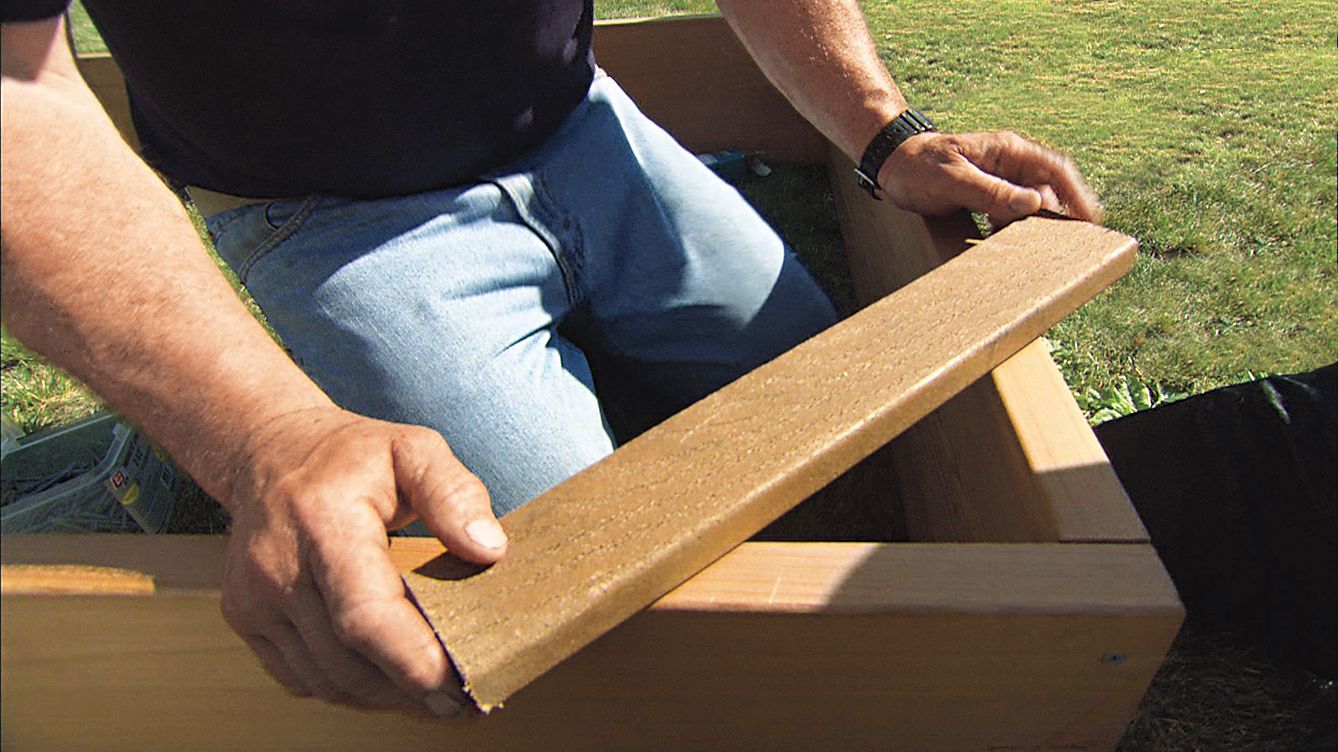
Once each corner is perfectly square, reinforce the corners with temporary scrap lumber. To do this, tack a short piece of decking across each corner with 3-inch screws to hold it in position.
Preparing the Site for Your Raised Bed Vegetable Garden
Next, prepare the site you’ve chosen for your raised bed by following these steps.
Step 1: Mark the Perimeter
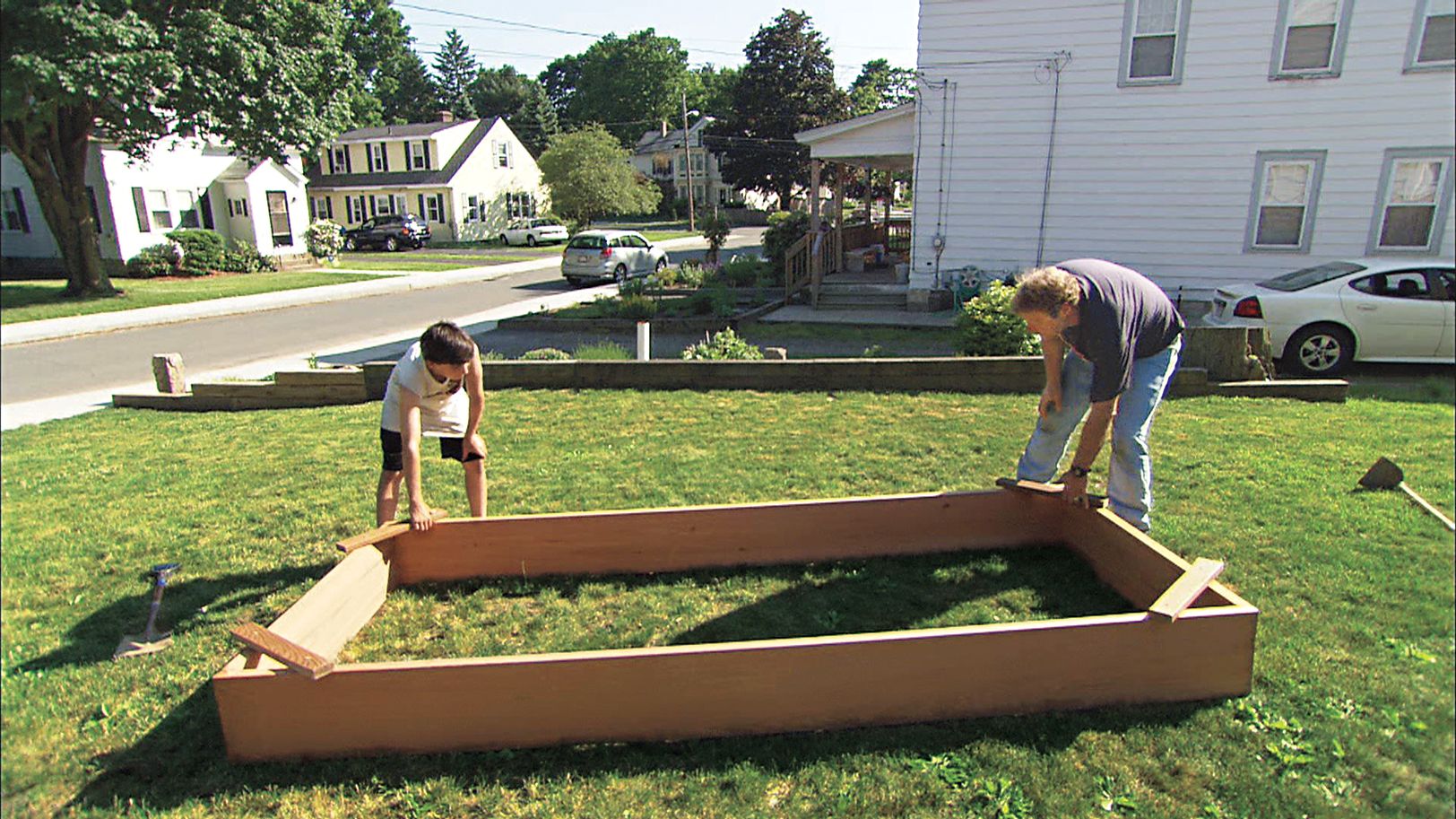
- Move the raised garden bed frame to your chosen sunny spot.
- Mark the ground around the frame’s outside perimeter using an edger or a spade.
Step 2: Prepare the Soil
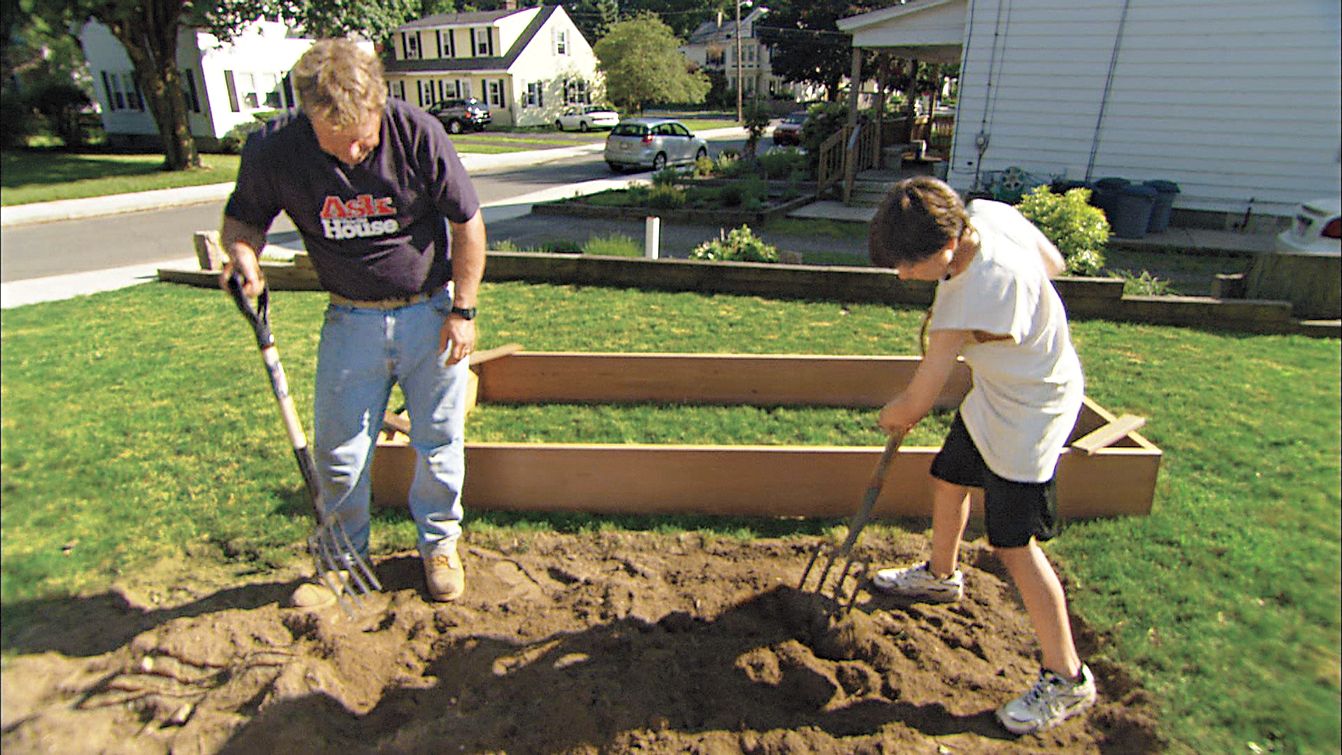
- Once you’ve got your markings, set the frame aside.
- Skim away the grass layer inside the area with either a sod cutter or grub hoe.
- Turn the soil beneath the bed with a pitchfork or rotary tiller to increase drainage.
Step 3: Level the Frame
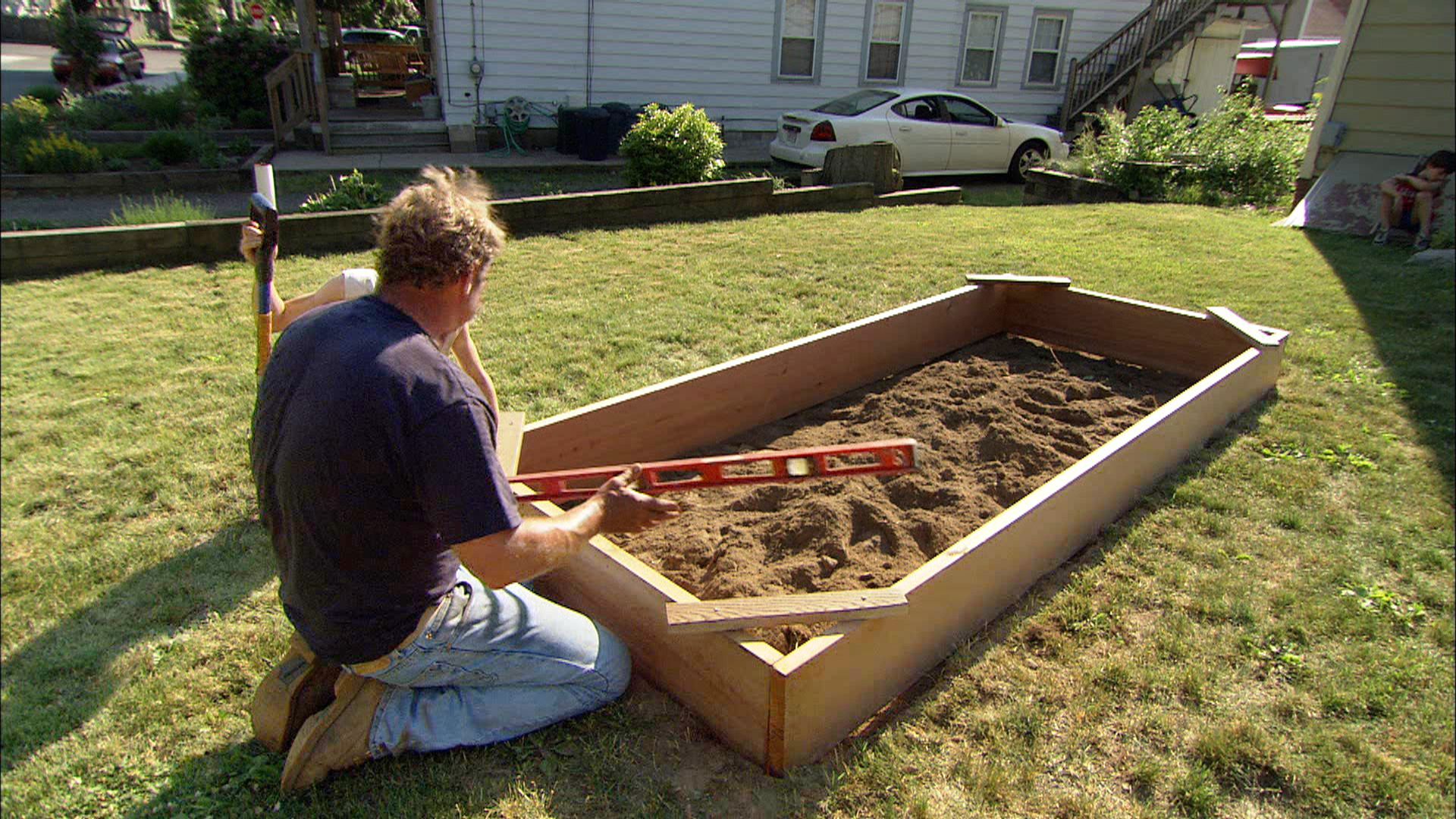
- Put the frame back in place and use a 4-foot level to see if it’s level with the ground.
- Dig out the soil beneath the frame as necessary until it sits level on all sides. This will ensure the frame is sturdy.
Securing the Raised Bed Frame With Stakes
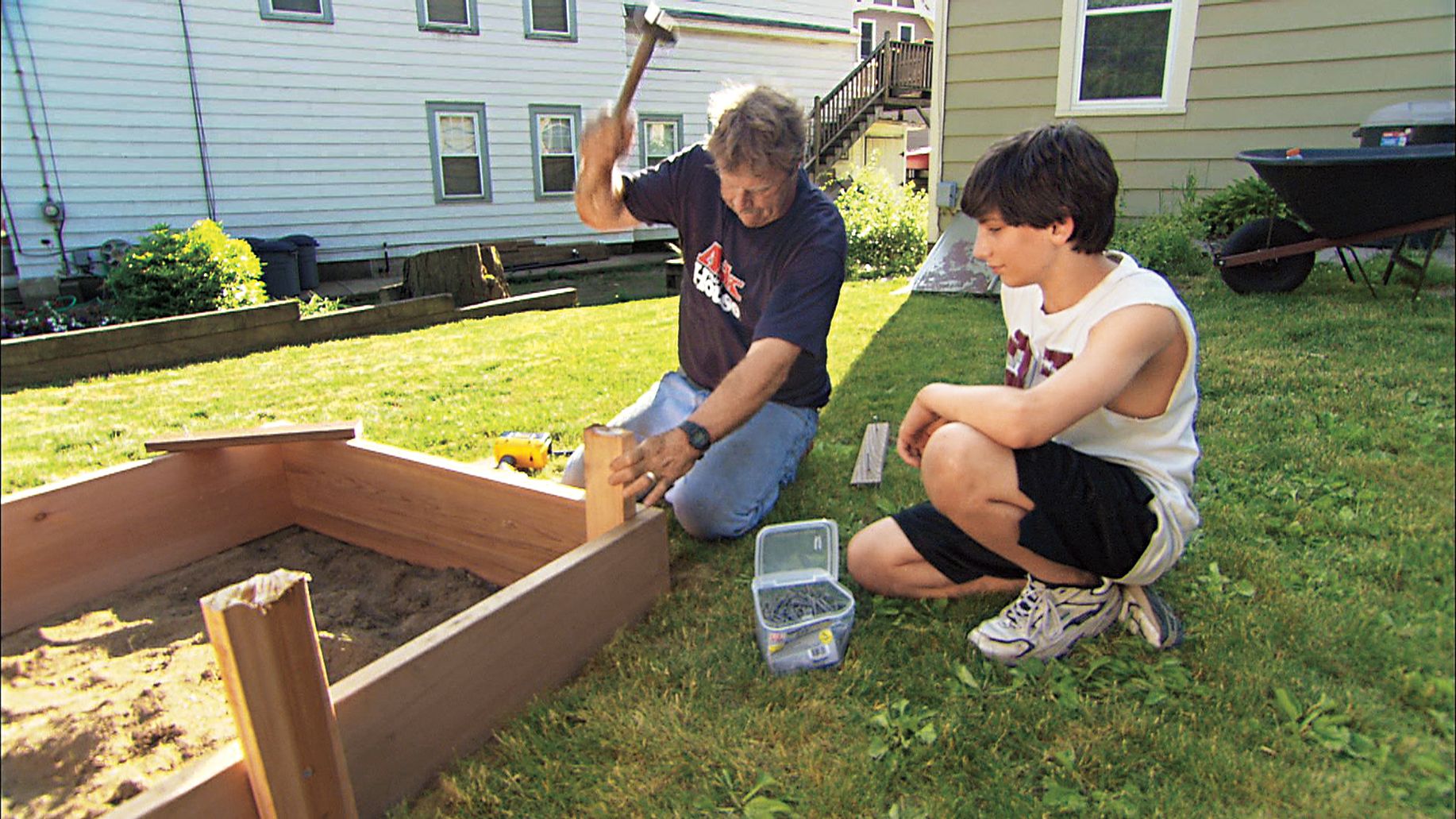
You can further stabilize your raised bed with stakes before you add soil by doing the following:
- Gather enough 2-foot 2×4 pieces to be able to place one stake every 2 1/2 feet along each of your frame’s long sides. Cook uses 10 2-foot 2x4s in the video, but you may need more or less depending on your own project’s size.
- When you cut each stake, make two diagonal cuts on the same end to create a point.
- Use a sledgehammer to drive the stakes at least 18 inches into the ground along the outside of the frame’s long sides.
- Secure each stake to the frame with your drill/driver and three 3-inch screws.
- Remove the temporary corner braces that you installed earlier.
- Drive a stake inside each corner.
- On one of the bed’s short sides, secure the stakes with screws going through the frame on both sides of each corner. Don’t screw the other short side yet.
Filling the Raised Garden Bed
Now it’s time to add your soil and plants. You can do this by following the steps below.
Step 1: Add Soil
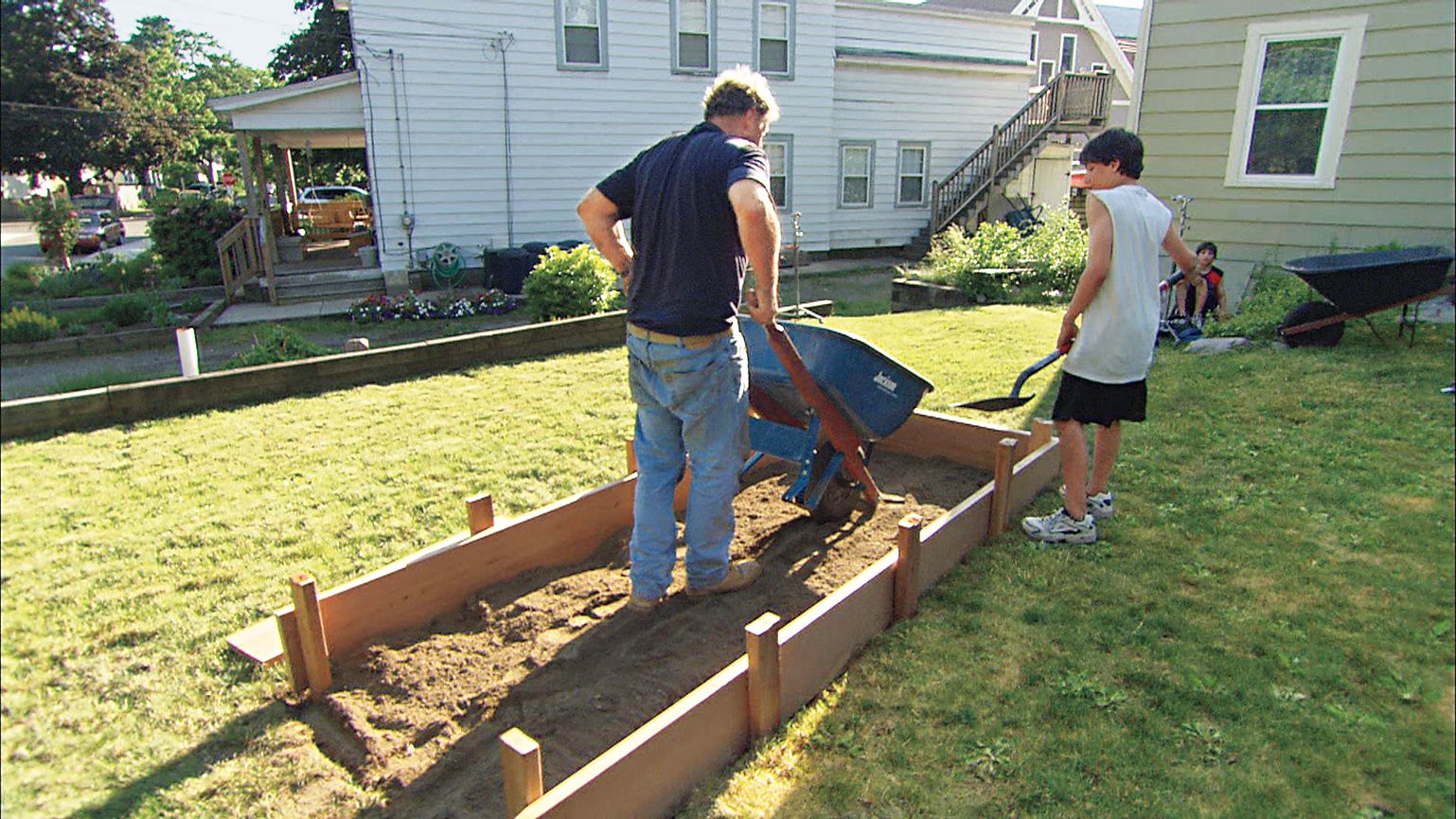
Now that your frame is secure, you can fill it with nutrient-rich soil before you attach the final side. Choose a soil mix that’s a good fit for the kinds of vegetables you’re growing. As Cook says, “The great thing about a raised garden is that you can put in the perfect soil for whatever you want to grow.”
- Take off the short side of the bed that you left unscrewed.
- Dump a mixture of soil and compost into the area with a wheelbarrow.
- Level out the soil and keep filling until the soil is 2–3 inches from the top of the frame.
Step 2: Reassemble the Frame
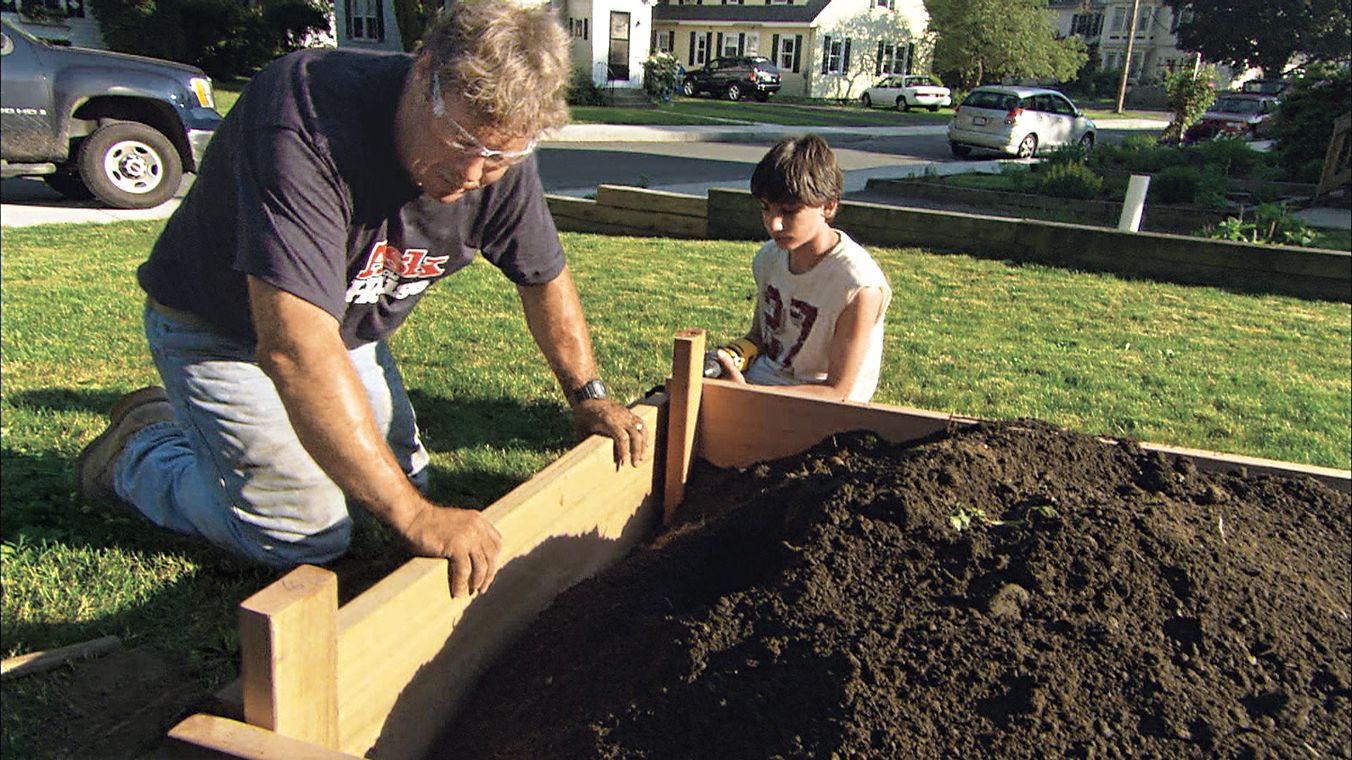
- Replace the short side of the bed and secure it to the long side and corner stakes with 3-inch screws.
- Cut the top of each stake flush with the top of the frame using a handsaw or a reciprocating saw.
Step 3: Plant Your Vegetables
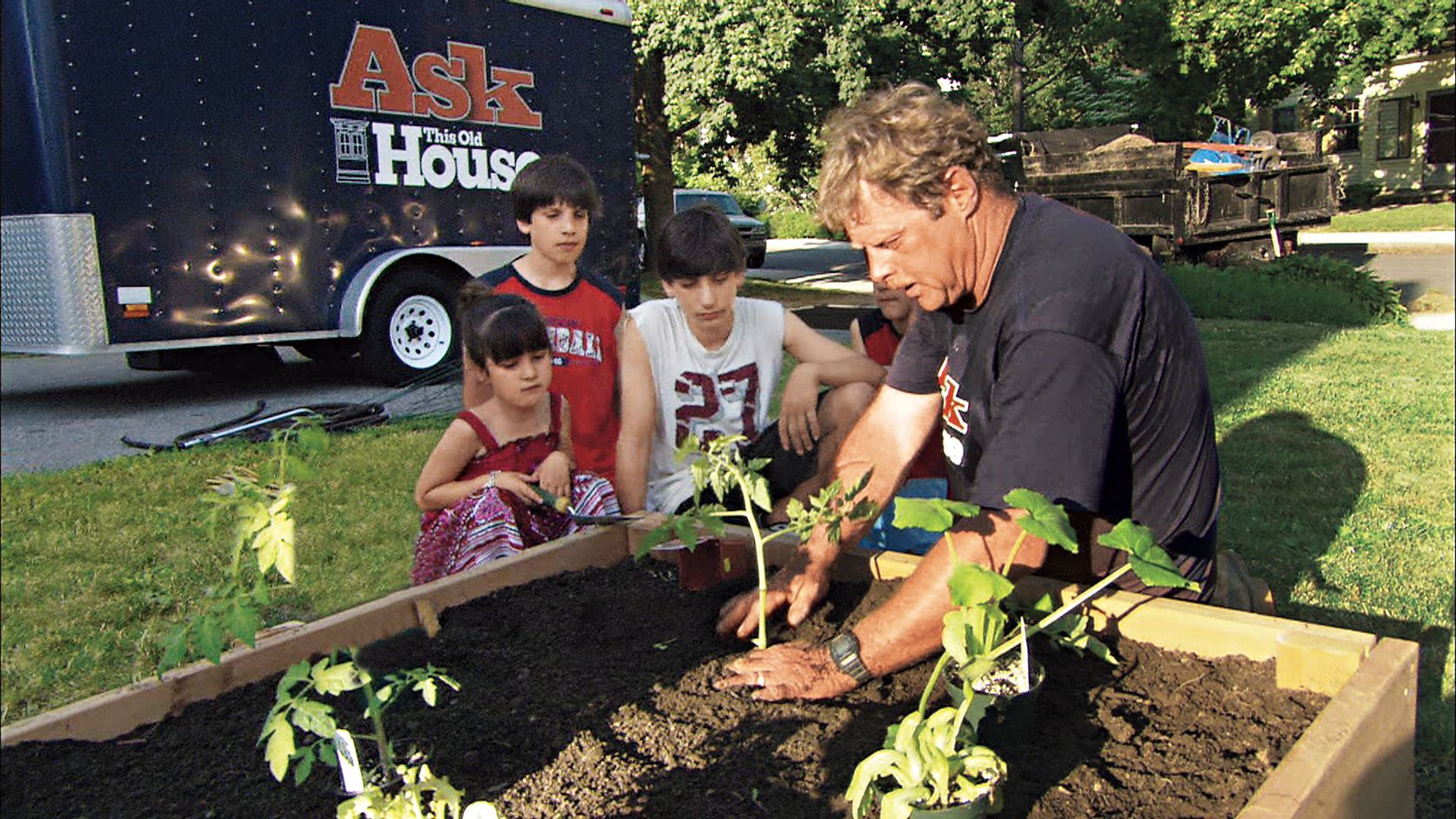
Your raised bed’s almost complete—all you need to do is add some plants as follows:
- Dig a small hole for each plant.
- Mix in the correct amount of starter fertilizer.
- Set the seeds and seedlings into the hole.
- Cover the hole with soil.
Step 4: Water and Mulch the Bed

Once you’ve planted everything you’d like, you can give your vegetables their first watering in their new home. Then, cover the soil with about an inch of mulch to keep the soil moist and stop weeds from growing. Cook used grass clippings from a previous mow.
Maintaining Your Raised Vegetable Garden
To keep your raised vegetable garden bountiful, follow these tips:
- Apply organic fertilizer as needed throughout the growing season.
- Consider rotating your plants each season to keep the soil healthy and reduce the risk of pests and disease.
- If you spot pests taking advantage of your plants, use organic pest control methods as necessary.
- Keep the soil consistently moist but don’t waterlog it. Water deeply and less frequently to encourage deep root growth.
- Sometimes, plants need pruning. Pick your vegetables off the bed regularly to encourage more growth.
- Weed the bed regularly to prevent pesky plants from competing with your vegetables for nutrients and water.
